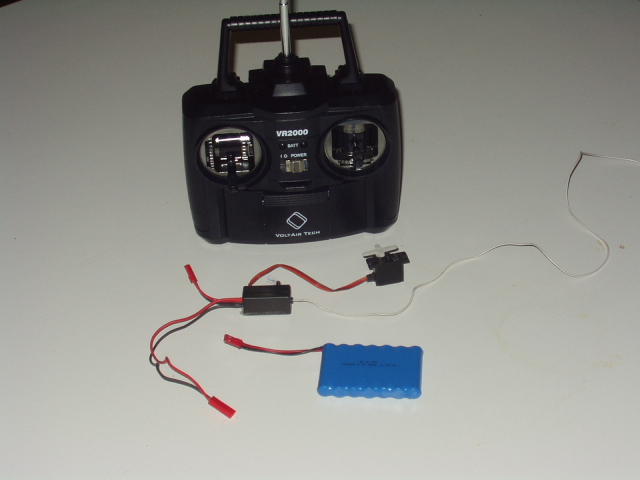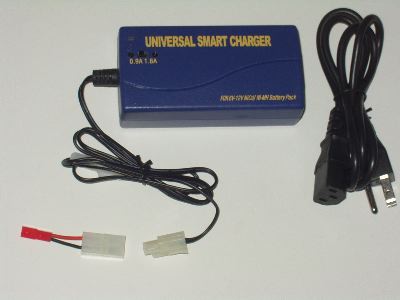RC Hovercraft
What RC Equipment is included?

A two stick, two channel RC transmitter with fully proportional steering and speed control. This is not a toy transmitter - this is a hobby quality 27mHz transmitter with servo reverse switches, servo trim levers, a built-in charging socket, and, best of all, a ratcheted throttle stick that lets you select exactly how fast you want to drive your hovercraft at any given moment. When you hold this transmitter in your hands, you'll notice right away that it feels like a high quality device. Requires 8 AA batteries (dry cell or rechargeable) or a standard RC transmitter battery (4 inch x 1 inch x 1 inch).
A lightweight combination receiver and speed control. The 2 channel receiver comes with a built-in 8 amp electronic speed control and two ports for servos (one port is unused with this kit's transmitter.) The ESC has a male JST connector for motor, a female JST connector for the battery. Total weight including the antenna and connectors is only 16.3 grams, and can be be reduced to 13.7 grams by removing the plastic case (very easy to do). �
A 9 gram GWS servo . Lots of torque, lots of precision.
Our custom parallel motor wiring harness. A lightweight and elegant solution to the problem of hooking up two motors. Connectors allow you to hookup the motors to the RC equipment with ease - no soldering or tools required.
Kits are available in six frequencies which allows you to operate up to six hovercraft models at the same time. Great for races!
What else is included?
An illustrated instruction booklet is provided to take you step by step through a quick assembly.
Additional instructions are included to show you how to build other two motor RC hovercraft.
Replacement foam hulls, should you need them, are packed with every kit. And of course, as with all kits from Goldstein Hovercraft, the parts to make a flying saucer are included.
How long does it take the smart charger to charge the battery?

About 50 minutes if the battery is fully discharged, but usually approximately 40 minutes. The charger detects when the battery has reached a full charge and automatically shuts off. A light shines red while the battery is charging, and switches to green when it is done. This is an even more important feature than the speed - it is nice to know when your battery is ready.
Other smart charger features: Accepts 110-240VAC, 50-60 Hz (can be used in Europe!). Charges batteries from 6V to 12V. Auto-cutoff by negative delta V. Two charging currents -- 0.9 A (for the kit's battery) or 1.8 A (for larger batteries).
How much run time on one battery charge?
Run time really depends on your driving style. The straightforward answer is that you'll get 9 or 10 minutes if you use full power constantly, but no one ever does that, and so everyone gets a longer run time. The radio has a very nice ratcheted speed control lever which lets you select whatever motor speed you like. When you are indoors, half power is plenty. On water, 3/4 power is still pretty fast, and half power is enough have fun. At half power, you'll get more like 20 minutes of run time, and on the lowest power setting that still is fun to use on a flat surface, you can get 34 minutes of continuous running. But that's not the whole story. The best way to drive the craft is to use bursts of power for turns, medium power for cruising, and then, to brake, use none at all so that the craft slides to a stop. So what feels like an exciting time of mostly full power hovering may actually involve some time where the battery isn't being discharged at all, and lots of times when it is discharged relatively slowly, and that will extend the time you're hovering by quite a bit.
If I purchase the no-charger, no battery option, what battery is required?
The RC GH-2 requires a battery ranging in size from AAA to AA. 900mAH to 1200mAH 2/3AA to 2/3A size cells work especially well. As for voltage, five cell (6.0 volts) through eight cell (9.6 volts) batteries all work, but 9.6 volts is ideal. The battery should have a JST RCY connector (also called a BEC connector by the RC industry.)
Batteries capable of discharging 6 amps or more will be needed for high speed runs, but nearly any battery will be good enough to have fun with. In general: 1) the greater the voltage, the greater the top speed, 2) the smaller the battery, the lighter the craft, but beware batteries which can't provide enough current and 3) the larger the battery, the longer the run time.
This page is under construction.
